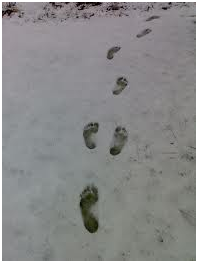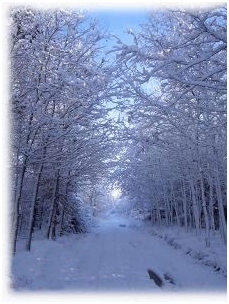Sole Running: Takes from the Trails

Barefoot Prints in the Snow
I know what you are thinking. Yes, winter running is challenging and can be downright difficult on so many levels, but it is also one of the most surreal running experiences you can undertake. Picture running across a frozen landscape with a layer of hoarfrost on the trees, seeing your frosty breath expelling from your mouth as you work that little bit harder to push the limits. Suddenly, you spot a deer or another woodland creature watching you through the trees, their breath steaming as it hits the cold air before finally they turn and bound away. The peace and tranquil surroundings entice you in as you follow the snowy path beside a frozen creek. The sound of silence is broken by the sudden sound of water as you come across a break in the ice where the water cascades over the rocks. Beauty at its best, in my opinion.
Winter running requires additional planning of course, not only in picking the right route for the day at hand, but also the right gear to ensure you get the perfect experience out of your running adventure.
I will start with the route. Before you head out into the white winter wonderland, you want to know
1. where you are going,
2. how long you are expecting to be gone, and
3. what the current and forecasted weather conditions are for the duration of the run.
These are all very important and will allow you to plan your run accordingly, to ensure you have the proper attire. Finding the right combination of clothing for the task at hand is critical to ensure you get the most out of your run. Dressing with the incorrect amount and type of layering can either have you too cold or too warm (although being too warm can be dealt with easier than being too cold).
This is a good link to give you a heads up on what you should be looking at for layering requirements, but don’t forget to experiment as well, as this would be a basic guideline, and everybody can and will be slightly different. Myself, the shoes withstanding, utilize a slightly modified version of this. I am not a big fan of fleece when I run because I overheat too quickly. I usually go with an Under Armor Cold Gear base (typically a turtle neck), with a tech shirt over top followed by my Solomon Acti Therm Jacket followed by a wind breaker or something similar. I do agree with the hat and the gloves both being very important, as the majority of your heat loss will be through your head and through your hands. If I keep them warm, as well as my core, I am good to go.
Almost as important is that you let someone know what your plan is, in case you run into some trouble. Always, and I mean always, let someone know what you are doing when going out for a winter run, especially if you are planning a trail run. Getting lost in the woods or encountering a sudden winter storm is not something to take lightly. Another item of note: if you are planning a trail run in the winter, ensure you have some emergency gear with you, a survival kit just in case.

Hoarfrost
I will tell you that I run barefoot in the winter, and there are a number of others across the northern hemisphere that have taken up the challenge to see how far they can push their bodies as well. This does not mean that it is meant for everybody, nor can you just take off your shoes and go for a snowy 5 km run. That would be just plain stupid. Running barefoot in the winter is just like anything else. You have to work up to it. You have to prepare your feet for the temps and conditions, and most of all you have to know your limits. Think about lifting weights. Would you be able to go to a gym and just squat 200lbs out of the blue? I seriously doubt it. It is the same with running barefoot in the winter. You need to get your feet used to the reduction in temperature by slowly exposing them to the temperature drops. This can be best achieved by running barefoot as much as possible throughout the year and into the fall. Even short spurts of exposure will allow your skin and feet adapt to the exposure that they will be experiencing once the temps drop below freezing.
This is my fourth year of running barefoot in the winter and unfortunately I cannot go without footwear all the time or I would get very little serious running in once the conditions turn. But I still get out there to log a mile or two barefoot when I can, because there is nothing like it, to push the boundaries that little bit to see how low you can go. It is interesting that people still have the same reactions as to any barefoot running. It’s either, “Who stole your shoes?” or “What mental facility did you break out of?” after they realize I am running that way on purpose. My friends think I am crazy as well, and I get questions all the time because people just want to know what type of person would put their feet through that? Well, the short and sweet of it is, me, that’s who. I am all about the experiences.
Here are some tips that I would like to share with anyone who might want to give this a whirl. So I have compiled a few thoughts on the subject and guidelines that I follow:
My keys to cold weather running and keeping the toes toasty are the following:
1. Keep moving. Stop and the potential for your feet to freeze to the ground increases dramatically.
2. Keep your head covered with a toque (what us Canucks call a Beanie I guess). Heat rises and guess where your head is? (Let’s keep your minds out of the gutter now people)
3. Layer accordingly above your waist. If it is really cold, I use Hot Pockets (instant heat) against my midsection to keep my core nice and toasty.
4. Good running pants are a must. Wear either tights or winter running gear like North face or Salomon (wind resistant) when it is really cold, because it is usually not the cold that gets you, it is the burn from the wind, which will freeze your upper legs. A good kilt works to. I have ran in a kilt in weather down to -30 degrees with no issues on the lower legs.
5. This may seem strange, but have something covering your ankles. I use wrist bands to cover them because when they are bare my feet seem to get colder quicker. I personally think it is because the ankle bone is so close to the skin surface and when there is less covering, the cold gets into the bones and works its way down to the feet. When the ankles are covered and warm, my feet just seem to stay warm so much better.
6. But the most important thing is to know your limits and do not push it beyond that. Otherwise, there is potential of doing some significant damage. As soon as you cannot feel the ground, stop and get something on your feet, because numb feet are dumb feet. Don’t take chances, because you only have two feet to work with.
Other than that get out there and have some fun, and give those silly shod runners something to talk about.
I hope this might pique your interest into trying something a little more unorthodox, as well as fun, like winter running, even if it is in shoes, because you just don’t know what you are missing until you give it a try.
Happy Trails,
Bob is a barefoot runner from Canada who has been lucky enough to discover the passion of running. From running 5 km around his neighborhood with his faithful husky Hazel to running 100 mile Ultra-marathons over nasty terrain, Bob runs with a smile and an encouraging spirit. You can also follow his ramblings at Canadian Running Magazine Online (http://runningmagazine.ca/blogs/bare-my-soles/ ) and his personal blog, http://winnipegbarefootrunners.blogspot.ca/.
Run Strong, Run Hard, Run Happy and Run Free……………….



